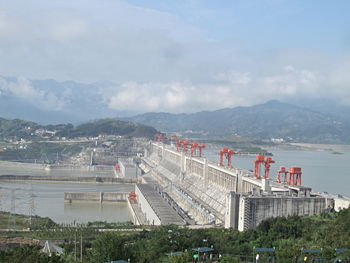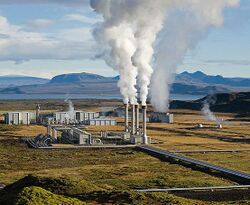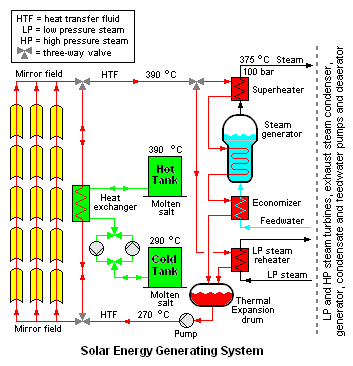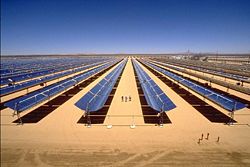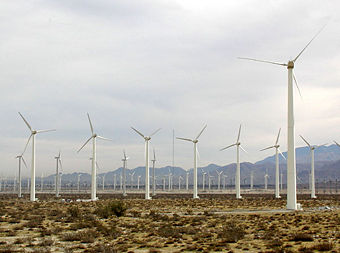Renewable energy
Renewable energy is energy derived from natural processes that are regularly replenished. Renewable sources and technologies include solar power, wind power, hydropower, geothermal power, biomass, biofuels, and possibly nuclear, if we can extract uranium from seawater.[1] Each of these has unique characteristics which influence how and where they are used.[2] What they all have in common is that they may be renewed or replenished; use does not constitute exhaustion.
About 18% of global final energy consumption comes from renewables, with 13% from traditional biomass (which is mainly used for heating) and 3% from hydroelectric power. The share of renewables in electricity generation is around 18%, with 15% of global electricity coming from hydroelectricity and 3.4% from new renewable energy sources.[3][4]
According to the International Energy Agency (IEA), renewable energy technologies can play an important role in addressing the challenges of moving towards clean, reliable, secure and competitive energy supply. Many countries have made progress in promoting renewables in their energy mix, but obstacles remain and, says the IEA, greater efforts are needed.[4]
Rationale for renewable energy
Renewable energy technologies are essential contributors to the energy supply portfolio, as they contribute to world energy security and, reduce dependency on fossil fuels, and provide opportunities for mitigating greenhouse gas emissions (namely carbon dioxide). The first two of these contributions affect global political and military security.
Political contributions
The politics of formulating reasonable and intelligent energy policy in an increasingly inter-dependent world poses a variety of challenges for most national governments in the current era. The subject of renewable energy has a number of highly technical aspects, fully understood only by scientists and engineers. It also has a variety of broadly recognized political, economic and social implications and unforeseen historical consequences. The unexpected political consequences resulting from simply changing from non-renewable energy sources (i.e., coal to oil) provides a good perspective of how a shift to renewable fuels can have unanticipated geopolitical effects.
Coal, a plentiful but nonrenewable resource, became a major energy source used in nineteenth century shipping, largely replacing the renewable wind energy of sailing ships. Yet, the first modern battleships were fuelled by oil rather than coal. This was done for sound engineering reasons, which would have the effect of enhancing the role of the Middle East in world politics. Previously, nations wanting its warships to operate worldwide needed a worldwide network of onshore coaling stations. Taking coal aboard was an exhausting operation for the crew and local labor, and required shore security for the coaling stations. Warships had no effective mechanical aids for moving coal into their furnaces, so it required a large number of brawny stokers with shovels, working in terrible conditions. Coal dust was as dirty and dangerous in ships as it is in coal mines; coal dust in the air can explode or spontaneous fires may break out under a variety of conditions.
Under the circumstances, oil had a variety of advantages. Oil could be transferred from ship to ship by pumps, and refueling could take place in any port, or later, at sea. Oil could easily be pumped into the furnaces, obviating the need for stokers, at a time when working conditions of laborers were frequently under close scrutiny. Since the main source of oil for the British Royal Navy in the late nineteenth century when it still ruled the seas was the Middle East, naval needs would be the keystone of British policy in that region. A secure source of oil had to be ensured above all else. Admiral Sir John (Jacky) Fisher called himself an "oil maniac" as early as 1886, and Winston Churchill made oil propulsion a matter of national policy in 1911. Part of the concern was the relative advantage of oil: Only oil could provide speeds of 25 knots or better, and Fisher and Churchill valued speed above armor for the fleet. To implement this policy, Britain invested directly in the Anglo-Persian Oil Company and, in relatively short order, "acquired 51 percent of company stock, placed two directors on its board, and negotiated a secret contract to provide the Admiralty with a 20-year supply of oil under attractive terms."[5]
Ensuring a dependable oil supply, if only for naval forces, became a policy consideration before the Second World War, and a major diplomatic conern The 1921 Cairo Conference that established the boundaries of modern Iraq, and named a Hashemite king — the Hashemites being the rivals of the House of Saud controlling Saudi Arabia was one of the enduring outcomes of that policy.
Especially after the Second World War, the explosive worldwide growth of gasoline-powered automobile transportation, and the shift from coal powered locomotives to diesel-fueled locomotives and trucks only accentuated the significance of oil-rich Middle East nations, while the decline of the British colonial empire had continuing consequences. This became especially obvious when Arab nations declared an oil boycott after the 1973 Arab-Israeli War. More and more, idealistic and utopian Western energy planners thought of inventive alternatives like electric cars or other oil-independent propulsion, but their proposals typically went unheeded by national publics enraptured with the economy and convenience that oil-based transportation made possible. Nuclear propulsion had, at times, been seen as attractive for naval vessels, but the costs eventually showed it was suitable only for aircraft carriers and submarines. Electric automobiles have been technically feasible for a number of years, but a variety of market and other forces have precluded widespread adoption.
While local and regional electrical blackouts occurred in the United States of America as early as 1965, electrical deregulation, and the financial incentive to buy power across a grid not designed for reliable large-scale power sale, made this an issue. While it might not be financially acceptable for electrical utilities to build traditional fossil-fueled plants, cogeneration became more attractive -- if it could be connected to the grid. Utilities were also more willing to look at fossil-independent generation to protect them from world market variations.
Environmental contributions
One of the most challenging consequences associated with the high levels of use of oil and coal. Fossil fuels, including oil and coal, produce the most emissions of carbon dioxide. Because of this, they would appear to be prime candidates to be replaced by renewable sources of energy that are not only replenished but also produce much lower levels of carbon dioxide emissions. Unfortunately, at this point, the nature of the problem is much clearer than the feasibility of any currently known solutions. The International Energy Agency estimates that nearly 50% of global electricity supplies would need to come from renewable energy sources in order to cut carbon dioxide emissions in half by 2050. At the same time, a variety of political and economic interests closely associated with fossil fuel industries have raised questions and sought to slow the adoption of renewable non-fossil fuel energy sources.
Renewable energy development
The term renewable energy covers a number of sources and technologies at different stages of commercialization. The International Energy Agency (IEA) has defined three generations of renewable energy technologies, reaching back over 100 years:
- First-generation technologies emerged with the industrial revolution in the late 18th century and include hydropower, biomass power, and geothermal power and heat. Beginning with the local water wheels and gear assemblies powering early factories in Great Britain, the United States and other industrial countries, these technologies proved highly feasible but were largely replaced by other first generation technologies that are still quite widely used.[6]
- Second-generation technologies include solar heating and cooling, wind power, modern forms of bioenergy, and solar photovoltaics. These are now entering markets as a result of research, development and demonstration (RD&D) investments since the 1980s. Initial investment was prompted by energy security concerns linked to the oil crises of the 1970s but the primary appeal of these technologies is due, at least in part, to environmental benefits. Many of the technologies reflect significant advancements in materials of construction.[6]
- Third-generation technologies are still under development and include advanced biomass gasification, biorefinery technologies, concentrating solar thermal power, hot dry rock (HDR) geothermal power, and ocean energy. Advances in nanotechnology may also play a major role.[6]
First-generation technologies are well established, second-generation technologies are emerging technologies, and third-generation technologies heavily depend on long-term R&D commitments, where the public sector has a role to play.[6]
First-generation technologies
First-generation technologies are widely used in locations with an abundance of the appropriate natural resources. Their future use depends on the exploration of the remaining resource potential, particularly in developing countries, and on overcoming challenges related to the environment and social acceptance.
Biomass
Biomass commonly refers to renewable organic materials such as wood, wood waste, straw, sugar cane, algae, and many other byproducts derived from a variety of agricultural and forestry production as well as other sources. Since biomass is derived from plants which were generated by utilizing solar energy in the photosynthesis process, it can also be defined as the organic material on Earth that has stored solar energy in the chemical bonds of the organic material.
The use of biomass for producing heat and electric power is a fully mature technology which offers a ready disposal mechanism for municipal, agricultural, and industrial organic wastes. However, the use of biomass remained relatively stagnant over the period of 1997 to 2007, even though demand for biomass (mostly wood) continues to grow in many developing countries. One of the problems of biomass is that material directly combusted in cook stoves produces pollutants, leading to health and environmental consequences, although improved cook stove programs are alleviating some of these effects. First-generation biomass technologies can be economically competitive, but may still require gaining public acceptance and overcoming small-scale issues.[6]
Hydroelectricity
Hydroelectric power plants have the advantage of being long-lived and many existing plants have operated for more than 100 years. Hydropower is also an extremely flexible technology from the perspective of power grid operation. Large hydropower provides one of the lowest cost options in today’s energy market, even compared to fossil fuels and there are no harmful emissions associated with plant operation.[6]
Hydroelectric power is currently the world’s largest installed renewable source of electricity, supplying about 17% of total electricity in 2005.[7] China is the world's largest producer of hydroelectric power in the world, followed by Canada.
However, there are several significant social and environmental disadvantages of large-scale hydroelectric power systems: dislocation of people living where the reservoirs are planned and disruption of aquatic ecosystems and birdlife.[8] Hydroelectric power is now more difficult to site in developed nations because most major sites within these nations are either already being used or may be unavailable for environmental reasons. The areas of greatest hydroelectric growth are the growing economies of Asia. India and China are the development leaders; however, other Asian nations are also expanding hydropower.
There is a strong consensus now that countries should adopt an integrated approach towards managing water resources, which would involve planning hydropower development in co-operation with other water-using sectors.[6]
Geothermal power and heat
Geothermal power plants can operate 24 hours per day, providing baseload capacity. Estimates for the world potential capacity for geothermal power generation vary widely, ranging from 40 GW by 2020 to as much as 6,000 GW.[9][10]
Geothermal power capacity grew from around 1 GW in 1975 to almost 10 GW in 2008.[10] The United States of America is the world leader in terms of installed capacity, representing 3.1 GW. Other countries with significant installed capacity include the Philippines (1.9 GW), Indonesia (1.2 GW), Mexico (1.0 GW), Italy (0.8 GW), Iceland (0.6 GW), Japan (0.5 GW), and New Zealand (0.5 GW).[10][11] In some countries, geothermal power accounts for a significant share of the total electricity supply, such as in the Philippines, where geothermal represented 17 percent of the total power mix at the end of 2008.[12]
Geothermal ground source heat pumps represented an estimated 30 gigawatts-thermal (GWth) of installed capacity at the end of 2008, with other direct uses of geothermal heat (i.e., for space heating, agricultural drying and other uses) reaching an estimated 15 GWth. As of 2008, at least 76 countries use geothermal energy in some form.
Second-generation technologies
Markets for second-generation technologies have been strong and growing over the past decade, and these technologies have gone from being a passion for the dedicated few to a major economic sector in countries such as Germany, Spain, the United States, and Japan. Many large industrial companies and financial institutions are involved and the challenge is to broaden the market base for continued growth worldwide.[6]
Solar Heating
Solar heating systems are a well known second-generation technology and generally consist of solar thermal collectors, a fluid system to move the heat from the collector to its point of usage, and a reservoir or tank for heat storage. The systems may be used to heat domestic hot water, swimming pools, or homes and businesses. The heat can also be used for industrial process applications or as an energy input for other uses such as solar assisted air conditioning.[13]
In many warmer climates, a solar heating system can provide a very high percentage (50 to 75%) of domestic hot water energy. As of 2009, China has 27 million rooftop solar water heaters.[14]
Solar thermal power stations
Solar thermal power stations include the 354 MW Solar Energy Generating Systems power complex in the U.S., Nevada Solar One (USA, 64 MW), Andasol 1 (Spain, 50 MW) and the PS10 solar power tower (Spain, 11 MW). Many other plants are under construction or planned, mainly in Spain and the USA.[3] In developing countries, three World Bank projects for integrated solar thermal and combined cycle gas turbine power plants in Egypt, Mexico, and Morocco have been approved.[15]
Photovoltaics
Photovoltaic (PV) cells, also called solar cells, convert light into electricity. In the 1980s and early 1990s, most photovoltaic modules were used to provide small, stand-alone power systems in areas with no electricity distribution system. However, from around 1995, industry efforts have focused increasingly on developing building-integrated photovoltaics and photovoltaic power plants for grid-connected applications.
As of October 2009, the largest photovoltaic (PV) power plants in the world are the Olmedilla Photovoltaic Park (Spain, 60 MW), the Puertollano Photovoltaic Park (Spain, 50 MW), the Moura Photovoltaic Power Plant (Portugal, 46 MW), and the Waldpolenz Solar Park (Germany, 40 MW).[16] The largest photovoltaic power plant in North America is the 25 MW DeSoto Next Generation Solar Energy Center in Florida. The plant consists of over 90,000 solar panels.[17]
At the end of 2008, the cumulative global PV installations reached 15,200 MW.[15] Photovoltaic production has been doubling every two years, increasing by an average of 48 percent each year since 2002, making it the world’s fastest-growing energy technology. The top five photovoltaic producing countries are Japan, China, Germany, Taiwan, and the United States.[18]
Wind power
Some of the second-generation renewables, such as wind power, have high potential and have already realized relatively low production costs.[19][20] At the end of 2009, worldwide wind power plant capacity was 157,900 MW, representing an increase of 31 percent during the year,[21] and wind power supplied some 1.3% of global electricity consumption.[22] Wind power is widely used in European countries, and more recently in the United States and in Asia.[23][24] Wind power accounts for approximately 19% of electricity generation in Denmark, 11% in Spain and Portugal, and 9% in the Republic of Ireland.[25] These are some of the largest "wind farms" in the world, as of January 2010:
| Wind farm | Installed capacity (MW) |
Country |
|---|---|---|
| Capricorn Ridge Wind Farm | 662 | United States |
| Fowler Ridge Wind Farm | 750 | United States |
| Horse Hollow Wind Energy Center | 736 | United States |
| Roscoe Wind Farm | 781 | United States |
| San Gorgonio Pass Wind Farm | 619 | United States |
| Tehachapi Pass Wind Farm | 690 | United States |
Modern forms of bioenergy
Global ethanol (C2H5OH) production for transport fuel tripled between 2000 and 2007 from 17 billion to more than 52 billion litres, while biodiesel expanded more than ten-fold from less than 1 billion to almost 11 billion litres. Biofuels provide 1.8% of the world’s transport fuel and recent estimates indicate a continued high growth. The main producing countries for transport biofuels are the United States, Brazil, and the European Union.[26]
The growing ethanol and biodiesel industries are providing jobs in plant construction, operations, and maintenance, mostly in rural communities. According to the Renewable Fuels Association, the ethanol industry created almost 154,000 U.S. jobs in 2005 alone, boosting household income by $5.7 billion. It also contributed about $3.5 billion in tax revenues at the local, state, and federal levels.[27]
Ethanol
Brazil has one of the largest renewable energy programs in the world, involving production of ethanol fuel from sugar cane, and ethanol now provides 18 percent of the country's automotive fuel. As a result of this and the exploitation of domestic deep water oil sources, Brazil, which for years had to import a large share of the petroleum needed for domestic consumption, recently reached complete self-sufficiency in liquid fuels.[28][29]
Most cars on the road today in the United States can run on blends of up to 10% ethanol, and motor vehicle manufacturers already produce vehicles designed to run on much higher ethanol blends. Ford, DaimlerChrysler, and General Motors are among the automobile companies that sell flexible-fuel cars, trucks, and minivans that can use gasoline and ethanol blends ranging containing up to 85% ethanol (E85). By mid-2006, there were approximately six million E85-compatible vehicles on U.S. roads. The challenge is to expand the market for biofuels beyond the farm states where they have been most popular. Flexible-fuel vehicles are assisting in this transition because they allow drivers to choose different fuels based on price and availability. The Energy Policy Act of 2005, which calls for 7.5 billion gallons of biofuels to be used annually by 2012, will also help to expand the market.[27]
Biodiesel
Existing diesel engines often can use, without modification, up to 20% biodiesel blends. Other engines can use 100% biodiesel.
Biodiesel is biodegradable, while petroleum diesel is not. Emissions from biodiesel are said to have less environmental impact.
Third-generation technologies
Third-generation renewable energy technologies are still under development and include advanced biomass gasification, biorefinery technologies, hot-dry-rock geothermal power, and ocean energy. Third-generation technologies are not yet widely demonstrated or have limited commercialization. Many are on the horizon and may have potential comparable to other renewable energy technologies, but still depend on attracting sufficient attention and RD&D funding.[6]
New bioenergy technologies
According to the International Energy Agency, cellulosic ethanol biorefineries could allow biofuels to play a much bigger role in the future than organizations such as the IEA previously thought. Cellulosic ethanol can be made from plant matter composed primarily of inedible cellulose fibers that form the stems and branches of most plants. Crop residues (such as corn stalks, wheat straw and rice straw), wood waste, and municipal solid waste are potential sources of cellulosic biomass. Dedicated energy crops, such as switchgrass, are also promising cellulose sources that can be sustainably produced in many regions of the United States.
| Company | Location | Feedstock |
|---|---|---|
| Abengoa Bioenergy | Hugoton, KS | Wheat straw |
| BlueFire Ethanol | Irvine, CA | Multiple sources |
| Gulf Coast Energy | Mossy Head, FL | Wood waste |
| Mascoma | Lansing, MI | Wood |
| POET LLC | Emmetsburg, IA | Corn cobs |
| Range Fuels[31] | Treutlen County, GA | Wood waste |
| SunOptal | Little Falls, MN | Wood chips |
| Xethanol | Auburndale, FL | Citrus peels |
Ocean energy
First proposed more than thirty years ago, systems to harvest utility-scale electrical power from ocean waves (referred to as wave farms) have recently been gaining momentum as a viable technology. The potential for this technology is considered promising, especially on west-facing coasts with latitudes between 40 and 60 degrees.[32]
In the United Kingdom, for example, the Carbon Trust recently estimated the extent of the economically viable offshore resource at 55 TWh per year, about 14% of current national demand. Across Europe, the technologically achievable resource has been estimated to be at least 280 TWh per year.[32] In 2003, the Electric Power Research Institute (EPRI) estimated the viable resource in the United States at 255 TWh per year (6% of demand).
Funding for a wave farm in Scotland was announced in February 2007 by the Scottish Executive, at a cost of over 4 million pounds, as part of a £13 million funding packages for ocean power in Scotland. The farm will be the world's largest with a capacity of 3 MW.[33]
The world's first commercial tidal power station was installed in 2007 in the narrows of Strangford Lough in Northern Ireland. The 1.2 megawatt underwater tidal electricity generator, part of Northern Ireland's Environment & Renewable Energy Fund program, takes advantage of the fast tidal flow (up to 4 metres per second) in the lough. Although the generator is powerful enough to power a thousand homes, the turbine has minimal environmental impact, as it is almost entirely submerged, and the rotors pose no danger to wildlife as they turn quite slowly.[34]
Enhanced geothermal systems
As of 2008, geothermal power development was under way in more than 40 countries, partially attributable to the development of new technologies, such as Enhanced Geothermal Systems (EGS).[15][The development of binary cycle power plants and improvements in drilling and extraction technology may enable enhanced geothermal systems over a much greater geographical range than "traditional" geothermal systems. Demonstration EGS projects are operational in the United States, Australia, Germany, France, and The United Kingdom.[35]
Nanotechnology thin-film solar panels
Solar power panels that use nanotechnology, which can create circuits out of individual silicon molecules, may cost half as much as traditional photovoltaic cells, according to executives and investors involved in developing the products. The Nanosolar company, in San Jose, California, has secured more than $100 million from investors to build a factory for nanotechnology thin-film solar panels. The company expects the factory to open in 2010 and produce enough solar cells each year to generate 430 megawatts of power.
Recent growth of renewables
From the end of 2004 to the end of 2008, solar photovoltaic (PV) capacity increased sixfold to more than 16 gigawatts (GW), wind power capacity increased 250 percent to 121 GW, and total power capacity from new renewables increased 75 percent to 280 GW. During the same period, solar heating capacity doubled to 145 gigawatts-thermal (GWth), while biodiesel production increased sixfold to 12 billion liters per year and ethanol production doubled to 67 billion liters per year.[15]
| Selected global indicators | 2004 | 2005 | 2006 | 2007 | 2008 |
|---|---|---|---|---|---|
| Annual investment in new renewable capacity | 30 | 38 | 63 | 104 | 120 billion USD |
| Existing renewables power capacity, including large-scale hydro |
895 | 930 | 1,020 | 1,070 | 1,140 GWe |
| Existing renewables power capacity, excluding large hydro |
160 | 182 | 207 | 240 | 280 GWe |
| Wind power capacity (existing) | 48 | 59 | 74 | 94 | 121 GWe |
| Biomass heating | ~250 GWth | ||||
| Solar hot water/ Space heating | 77 | 88 | 105 | 126 | 145 GWth |
| Geothermal heating | ~50 GWth | ||||
| Ethanol production (annual) | 30.5 | 33 | 39 | 50 | 67 billion liters |
| Number of countries with policy targets for renewable energy use |
45 | 49 | 66 | 73 |
Annual percentage growth for 2008 was significant. Wind power grew by 29 percent and grid-connected solar PV by 70 percent. The capacity of utility-scale solar PV plants (larger than 200 kilowatts) tripled during 2008, to 3 GW. Solar hot water grew by 15 percent, and annual ethanol and biodiesel production both grew by 34 percent. Heat and power from biomass and geothermal sources continued to grow, and small hydroelectric power sources increased by about 8 percent.[15]
In 2008, for the first time, more renewable energy than conventional power capacity was added in both the European Union and United States, demonstrating a "fundamental transition" of the world's energy markets towards renewables, according to a report released by REN21, a global renewable energy policy network based in Paris.[36]
References
- ↑ The supply is unlimited. The cost of extraction is the big challenge. Cost_of_nuclear_power#Cost_of_fuel
- ↑ Renewable energy... into the mainstream From the IEA website
- ↑ Jump up to: 3.0 3.1 Renewables 2007 Global Status Report From website of the Renewable Energy Policy Network for the 21st Century (REN21)
- ↑ Jump up to: 4.0 4.1 Deploying Renewables From the IEA website
- ↑ Erik Dahl (Winter 2000-2001), "Naval Innovation: from Coal to Oil", Joint Forces Quarterly
- ↑ Jump up to: 6.0 6.1 6.2 6.3 6.4 6.5 6.6 6.7 6.8 Renewables in global energy supply: An IEA facts sheet From the IEA website.
- ↑ Review of Solutions to Global Warming, Air Pollution, and Energy Security Mark Z. Jacobson (2009). From the website of the Stanford University in Stanford, California
- ↑ Hydroelectric power's dirty secret revealed From the website of New Scientist, 24 February 2005.
- ↑ "What is Geothermal Potential?", IGA News. From the website of the International Geothermal Association.
- ↑ Jump up to: 10.0 10.1 10.2 The possible role and contribution of geothermal energy to the mitigation of climate change From Proceedings of IPCC Scoping Meeting on Renewable Energy Sources, Luebeck, Germany, 20-25 January 2008, p. 59-80.
- ↑ U.S. Geothermal Energy Market Report 2009 From website of the Islandsbanki, Iceland
- ↑ Philippines targets $2.5 billion geothermal development, Leonora Walet, Reuters, November 5, 2009.
- ↑ Solar assisted air-conditioning of buildings From the IEA website.
- ↑ Lester R. Brown (2009). Plan B 4.0: Mobilizing to Save Civilization (Earth Policy Institute), 1st Edition. W.W. Norton Company, p.122. ISBN 0-393-07103-0. Full copy available online here
- ↑ Jump up to: 15.0 15.1 15.2 15.3 15.4 15.5 Renewables Global Status Report: 2009 Update From website of the Renewable Energy Network for the 21st Century (REN21)
- ↑ World's largest photovoltaic power From website of Photovoltaic Resources.com
- ↑ FPL Commissions DeSoto Next Generation Solar Energy Center Energy Online, October 28, 2009.
- ↑ Solar Cell Production Jumps 50 Percent in 2007 From the website of the Earth Policy Institute.
- ↑ "Stabilizing Climate" (PDF) A chapter in: Lester R. Brown (2006). Plan B 2.0: Rescuing a Planet Under Stress and a Civilization in Trouble, 1st Edition. W.W. Norton Company, p. 122. ISBN 0-393-06162-0.
- ↑ The Clean Tech Revolution... the costs of clean energy are declining
- ↑ Gains in Global Wind Capacity Reported From the website of The New York Times, May 27, 2010
- ↑ Wind turbines generate more than 1 % of the global electricity February 2008. From the website of the World Wind Energy Association (WWEA)
- ↑ Global wind energy markets continue to boom – 2006 another record year. From the website of the Global Wind Energy Council (GWEC)
- ↑ Global Wind 2008 Report From the website of the Global Wind Energy Council (GWEC)
- ↑ IEA Wind Energy: Annual Report 2008 From the website of the IEA
- ↑ Assessing Biofuels (2009) From the website of the United Nations Environment Programme
- ↑ Jump up to: 27.0 27.1 American energy: The renewable path to energy security (2006) From the website of the Worldwatch Institute Center for American Progress
- ↑ America and Brazil Intersect on Ethanol (May 15, 2006) From the website of RenewableEnergyWorld.com
- ↑ New Rig Brings Brazil Oil Self-Sufficiency (April 21, 2006) From the website of The Washington Post
- ↑ U.S. Cellulosic Ethanol Plants, New or Under Construction
- ↑ Range Fuels receives $80 million loan
- ↑ Jump up to: 32.0 32.1 Jeff Scruggs and Paul Jacob. Harvesting Ocean Wave Energy, Science, Vol. 323, p. 1176, 27 February 2009.
- ↑ Orkney to get 'biggest' wave farm BBC News, 20 February 2007.
- ↑ World tidal energy first for NI, BBC News BBC News, 7 June 2007.
- ↑ Bertani, Ruggero (2009), Geothermal Energy: An Overview on Resources and Potential From Proceedings of the International Conference on National Development of Geothermal Energy Use, Slovakia
- ↑ Jump up to: 36.0 36.1 Renewables Global Status Report 2009 Update From the website of RenewableEnergyWorld.com
- ↑ Renewables Global Status Report: 2006 Update From website of the Renewable Energy Network for the 21st Century (REN21)
